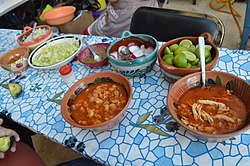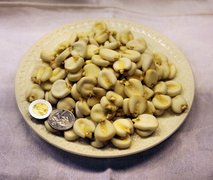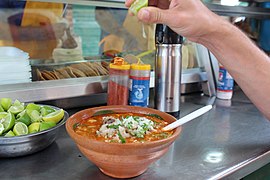Pozole
 Pozole verde at a restaurant in Mexico City (2018) | |
| Type | Soup |
|---|---|
| Place of origin | Mexico |
| Region or state | Central Mexico |
| Created by | Nahuas |
| Serving temperature | Hot |
| Main ingredients | Hominy, meat (usually pork or chicken), chile peppers, seasonings |
| Variations | Blanco, Verde, Rojo |
Pozole (Spanish pronunciation: [po'sole]; from Nahuatl languages: pozolli, meaning cacahuazintle, a variety of corn or maize) is a traditional soup or stew from Mexican cuisine. It is made from hominy with meat (typically chicken or pork), and can be seasoned and garnished with shredded lettuce or cabbage, chili peppers, onion, garlic, radishes, avocado, salsa or limes. Known in Mesoamerica since the pre-Columbian era, the stew is common across Mexico and neighboring countries, served both as a day-to-day meal and as a festive dish.
Description
[edit]Pozole can be prepared in many ways, but all variations include a base of cooked hominy in broth. The broth is most commonly made with chicken or pork, but vegetarian preparations exist. When the broth is meat-based, pieces of the meat used to make the broth are usually served in the final dish; vegetarian versions substitute beans for the meat.
The three main types of pozole are blanco (white),[1] verde (green), and rojo (red). Pozole blanco—"white pozole"—is the preparation without any additional green or red sauce. Pozole verde—"green pozole"—adds a rich salsa verde based on green ingredients, possibly including tomatillos, epazote, cilantro, green chiles (typically jalapeños or serranos), or pepitas. Pozole rojo—"red pozole"—is similar, but using a salsa roja made from one or more dried or smoked red chiles, such as guajillo, piquin, or ancho, and usually tomato.
Pozole is commonly served accompanied by a wide variety of toppings, particularly raw vegetables. Common toppings include chopped onion, shredded cabbage, sliced radish, avocado, limes, oregano, tostadas, chicharrón, and chiles.[2]
Regional customs
[edit]Pozole is also considered a festive dish. In Mexico and in New Mexico, pozole is typically served on New Year's Eve to celebrate the new year.[3][4] Pozole is frequently served as a celebratory dish throughout Mexico and in Hispanic communities outside Mexico. Other occasions for serving pozole include Mexican Independence Day, birthdays, Christmas, and other holidays.[5]

Pozole is a typical dish in various states, such as Nayarit, Sinaloa, Michoacán, Guerrero, Zacatecas, Jalisco, and Morelos. Pozole is served in Mexican restaurants worldwide. It is also popular in the cuisine of New Mexico where it is known as posole, and is a common dish among the Puebloan Indigenous peoples residing along the Rio Grande.[6][7]
In the Southwestern United States, a type of field corn (posole corn) is used that differs from hominy. It is considered to be more flavorful and has a firmer texture than hominy which tends to be softer and mushier than posole.[8] The Hopi people make a variety called noquivi (Hopi: nöqkwivi), using lamb or mutton rather than the traditional pork.[9] It is often made from dried blue corn posole kernels; green chiles and juniper berries (instead of bay leaves) are added to the stew. This variety of posole is also prepared by the Puebloan people of New Mexico.[10]
History
[edit]
Pozole was mentioned in the 16th century Florentine Codex by Bernardino de Sahagún.[12] Since maize was a sacred plant for the Aztecs and other inhabitants of Mesoamerica, pozole was made to be consumed on special occasions.
According to research by the Instituto Nacional de Antropología e Historia (National Institute of Anthropology and History) and the Universidad Nacional Autónoma de México, on these special occasions, the meat used in the pozole may have been human. Possible archeological evidence of mass cannibalism may support this theory,[11] and there is widespread scholarly agreement that the Aztecs practiced cannibalism in the context of human sacrifice and warfare, though the social and dietary significance of such acts is disputed. While some authors such as Marvin Harris suggest that human flesh was a significant part of an aristocratic diet, others argue that there was not sufficient human flesh available to be a major source of proteins and that its consumption was chiefly a status symbol.[13][14]
Gallery
[edit]-
White pozole
-
Cooked hominy
-
Dried hominy can be used for pozole, but it must be soaked and cooked.
-
Dried New Mexican blue posole field corn
-
Pozole topped with sliced avocado
-
Green pozole, cooked in Guerrero State fashion
-
Green pozole, with condiments, served in Zihuatanejo (Guerrero)
-
Red pozole, served in Mexico City
-
Red pozole, served in Oaxaca de Juárez
See also
[edit]- Fricasé
- List of maize dishes
- List of Mexican dishes
- List of soups
- List of stews
- Menudo (soup) – a similar dish made with tripe
- Mexican cuisine
References
[edit]- ^ Cookpad: Pozole Blanco
- ^ Bauer, Elise (8 October 2011). "Authentic Pozole Rojo (Red Posole) Recipe". Simply Recipes. Retrieved 13 May 2019.
- ^ Anonymous; Seibert, Sandra; Anonymous; Pharo, Christine; Anonymous; Morethanbeefandtaters; Anonymous; G., Pauline; M., Monica (16 November 2016). "Posole Rojo". Food Network. Retrieved 13 May 2019.
- ^ "Red Posole with Pork". Epicurious. 30 May 2017. Retrieved 13 May 2019.
- ^ "Mexican Pozole". Mexico. Retrieved 13 May 2019.
- ^ Cocking, Lauren (12 February 2017). "A Brief History of Pozole, Mexico's Take on Traditional Stew". Culture Trip. Retrieved 13 May 2019.
- ^ Butel, Jane (11 December 1994). "Sacred Stew : Posole, a Native American corn dish, is served at pueblo festivals, but it can also be sampled in restaurants around Albuquerque". Los Angeles Times. Retrieved 13 May 2019.
- ^ Butel, Jane (11 December 1994). "Sacred Stew : Posole, a Native American corn dish, is served at pueblo festivals, but it can also be sampled in restaurants around Albuquerque". The Los Angeles Times. Retrieved 3 January 2024.
- ^ Manus, Mihio (17 September 2013). "Native American Day at Hopi High" (PDF). Vol. 21, no. 18. The Hopi Tutuveni. Retrieved 3 January 2024.
- ^ "Blue Corn Posole Stew". Rim Journal. Retrieved 3 January 2024.
- ^ a b Pozolli. (n.d.). Nahuatl dictionary. Retrieved 28 August 2012, from http://whp.uoregon.edu/dictionaries/nahuatl/index.lasso
- ^ Bernardino de Sahagún, Florentine Codex: General History of the Things of New Spain (Translation of and Introduction to Historia General de Las Cosas de La Nueva España; 12 Volumes in 13 Books ), trans. Charles E. Dibble and Arthur J. O Anderson (Salt Lake City: University of Utah Press, 1950–1982). Images are taken from Fray Bernardino de Sahagún, The Florentine Codex. Complete digital facsimile edition on 16 DVDs. Tempe, Arizona: Bilingual Press, 2009. Reproduced with permission from Arizona State University Hispanic Research Center.
- ^ "Opinion: To Aztecs, Cannibalism Was a Status Symbol". The New York Times. 6 January 1987.
- ^ Ortiz de Montellano, Bernard R. (12 May 1978). "Aztec Cannibalism: An Ecological Necessity?". Science. 200 (4342): 611–617. Bibcode:1978Sci...200..611O. doi:10.1126/science.200.4342.611. JSTOR 1746929. PMID 17812682. S2CID 35652641.





















